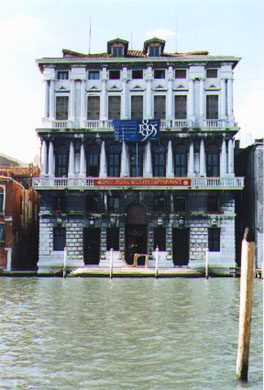Ca' Cornaro della ReginaGrand Canal, S. Cassiano Parish (S. Polo)
Much later, in
1723, in accordance with the testamentary wishes of their uncle Cav
Proc. Federico Prospero Cornaro (H-31), Proc.
Andrea Antonio Giuseppe Cornaro (H-39) and his brother Sen.
Federico Antonio Alberto Cornaro (H-40) razed the old palace and
commissioned the architect Domenico Rossi
to erect the present structure on the site. Costantino Cedini and Vincenzo
Colomba created the frescos and stucco decoration.
Deborah Howard
comments in The Architectural History of Venice (p. 196): "The
sober classical detail of the facade is indicative of the change under
way in Venetian architectural taste, though an element of Baroque extravagance
survives in the enormous keystone heads of the pianterreno." Wittkower
states in Art & Architecture in Italy 1600-1750 (p. 252) that
the structure marks "the return to a classical architecture" after the
excesses of Rococo and Baroque.
In 1802 Caterino Antonio Cornaro, upon his death without descendants, bequeathed the palace and all its paintings to Pope Pius VII. The property passed in 1817 to a Venetian monastic order and later to the city government of Venice. Since 1975 the palace has housed the administrative offices of La Biennale di Venezia, and it is frequently draped with the banners of that celebrated organization. Home | Palaces | Chapels | Villas | Paintings | Theaters Family | Links |
© 1997-8 C. I. Gable